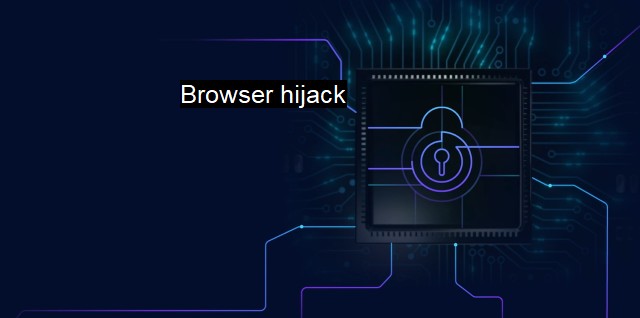What is Browser hijack?
Protecting Your Browser: Understanding the Threat of Browser Hijacking and Cyber Attacks on Your Personal Data and Security
Browser hijacking occurs when unwanted software on an internet browser alters the activity of the browser without the user's consent. This term is often used to refer to software that alters a web browser's settings, by adding unnecessary toolbars to a browser or altering the user's homepage to serve the hijacker's needs. this poses a significant threat to users' internet safety and has become a thriving playground for cybercriminals, with instances of browser hijacking continuously on the rise worldwide.Browser hijackers aim to control a user's internet interaction. Often, they change the default home page or search page, or add additional toolbars to the user's browser window. Predominantly, hijackers are geared toward redirection, leading users to a desired website, which could be controlled by someone spreading spam or spyware. In more dangerous scenarios, browser hijacking can be used to steal personal data or hand over control of a user's device to a hacker.
There are various objectives behind browser hijacking, predominantly driven by financial gain. Advertising revenue often drives this activity: through injecting targeted advertisements into browsing sessions or pushing users towards sponsored websites. Alongside this, data theft is a primary motivation. By encouraging users unwittingly to visit websites, attackers can collect sensitive information transported via cookies, or capture new data when users fill out forms. The stolen data can then be monetized directly, as in cases of credit card theft, or indirectly when bundled and sold on to third-party companies.
The development and distribution of browser hijackers have become increasingly sophisticated. Some are bundled within seemingly legitimate applications, while others deceptively mimic website pop-ups warning of real security threats that scare users into unwitting installation. Advanced variants can even prevent users from modifying browser settings, disabling antivirus software, or implementing defenses against other malware types.
At the core of eliminating or preventing browser hijacking is strong antivirus software. Regularly updating browser software and antivirus software is one common defense. Developers are continually releasing security patches that address vulnerabilities that could be potentially exploited by hijackers. Therefore, browsers without the latest updates could be left exposed to hijackers due to unpatched loopholes.
Good antivirus software serves as an additional and often the most effective line of defense. Antivirus software can scan files to detect harmful software, creating a more conducive environment for a safer internet experience. Minimally, antivirus software notifies users when they attempt to install identified hijackers, allowing for individuals to opt-out of potential harm. Advanced antivirus solutions neutralize threats before they have a chance of causing harm to a computer by blocking download attempts from known malicious sites.
Despite having strong antivirus software, cautious internet usage is also necessary for reducing the risk associated with browser hijackers. Users should avoid untrusted websites and carefully observe details when installing new software, ensuring no supplementary, potentially ill-intentioned, applications tag along. Having alertness to this societal and technical concern engenders a proactive rather than reactive approach to potential browser hijacking attacks.
Browser hijacking is a growing threat in the digital world, often motivated by financial gain and resulting in problematic consequences for unwary users. Its methods range from simple webpage redirection to complex information theft and control over user devices. Antivirus software, coupled with careful internet consumption habits, present an effective defense against this intrusive software. Incorporation of prudent online practices solidify checks in line with evolving cyber attack and defence strategies. It thus underscores how critical digital hygiene grounded in cybersecurity awareness is essential for the safety and the potency of our digital interactions.

Browser hijack FAQs
What is a browser hijack?
A browser hijack is a type of cybersecurity threat that takes over your web browser settings and redirects your web traffic to malicious websites. The hijacker usually gains access to your browser by exploiting vulnerabilities or by tricking you into installing malicious software.What are the signs of a browser hijack?
The signs of a browser hijack include: your homepage or default search engine being changed without your consent, new toolbars or extensions being added to your browser, pop-up ads appearing frequently, and your browser running slowly or crashing frequently.How can I protect my browser from hijackers?
To protect your browser from hijackers, you should keep your antivirus and anti-malware software up to date, avoid clicking on suspicious links or ads, only download software from reputable sources, and regularly clear your browser cache and cookies. You can also use browser extensions like AdBlock Plus or uBlock Origin to block pop-up ads and other forms of unwanted content.What should I do if my browser is hijacked?
If your browser is hijacked, you should run a virus scan with your antivirus software and remove any detected threats. You can also try resetting your browser settings to their default values, uninstalling any suspicious browser extensions or add-ons, and changing your passwords for any online accounts that may have been compromised. If these steps don't work, you may need to seek help from a cybersecurity professional.| | A | | | B | | | C | | | D | | | E | | | F | | | G | | | H | | | I | | | J | | | K | | | L | | | M | |
| | N | | | O | | | P | | | Q | | | R | | | S | | | T | | | U | | | V | | | W | | | X | | | Y | | | Z | |
| | 1 | | | 2 | | | 3 | | | 4 | | | 7 | | | 8 | | |||||||